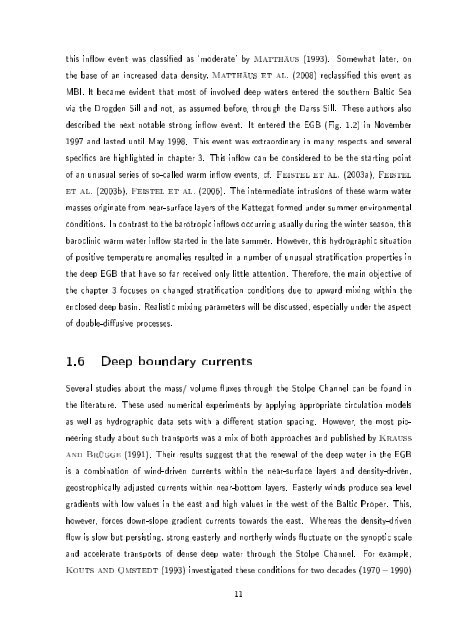Baltic Sea
Baltic Sea
Baltic Sea
You also want an ePaper? Increase the reach of your titles
YUMPU automatically turns print PDFs into web optimized ePapers that Google loves.
this inow event was classied as 'moderate' by Matthäus (1993). Somewhat later, on<br />
the base of an increased data density, Matthäus et al. (2008) reclassied this event as<br />
MBI. It became evident that most of involved deep waters entered the southern <strong>Baltic</strong> <strong>Sea</strong><br />
via the Drogden Sill and not, as assumed before, through the Darss Sill. These authors also<br />
described the next notable strong inow event. It entered the EGB (Fig. 1.2) in November<br />
1997 and lasted until May 1998. This event was extraordinary in many respects and several<br />
specics are highlighted in chapter 3. This inow can be considered to be the starting point<br />
of an unusual series of so-called warm inow events, cf. Feistel et al. (2003a), Feistel<br />
et al. (2003b), Feistel et al. (2006). The intermediate intrusions of these warm water<br />
masses originate from near-surface layers of the Kattegat formed under summer environmental<br />
conditions. In contrast to the barotropic inows occurring usually during the winter season, this<br />
baroclinic warm water inow started in the late summer. However, this hydrographic situation<br />
of positive temperature anomalies resulted in a number of unusual stratication properties in<br />
the deep EGB that have so far received only little attention. Therefore, the main objective of<br />
the chapter 3 focuses on changed stratication conditions due to upward mixing within the<br />
enclosed deep basin. Realistic mixing parameters will be discussed, especially under the aspect<br />
of double-diusive processes.<br />
1.6 Deep boundary currents<br />
Several studies about the mass/ volume uxes through the Stolpe Channel can be found in<br />
the literature. These used numerical experiments by applying appropriate circulation models<br />
as well as hydrographic data sets with a dierent station spacing. However, the most pioneering<br />
study about such transports was a mix of both approaches and published by Krauss<br />
and Brügge (1991). Their results suggest that the renewal of the deep water in the EGB<br />
is a combination of wind-driven currents within the near-surface layers and density-driven,<br />
geostrophically adjusted currents within near-bottom layers. Easterly winds produce sea level<br />
gradients with low values in the east and high values in the west of the <strong>Baltic</strong> Proper. This,<br />
however, forces down-slope gradient currents towards the east. Whereas the density-driven<br />
ow is slow but persisting, strong easterly and northerly winds uctuate on the synoptic scale<br />
and accelerate transports of dense deep water through the Stolpe Channel. For example,<br />
Kouts and Omstedt (1993) investigated these conditions for two decades (1970 − 1990)<br />
11



